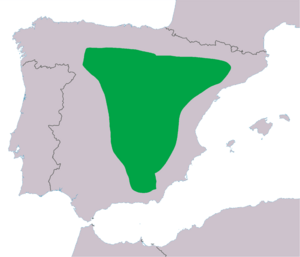Hesperides' parsley frog facts for kids
Quick facts for kids Hesperides' parsley frog |
|
|---|---|
| Scientific classification | |
| Genus: |
Pelodytes
|
| Species: |
hespericus
|
 |
|
The Hesperides' parsley frog, officially named Pelodytes hespericus, is a special kind of frog. It belongs to a group of frogs called the Pelodytidae family. This unique frog can only be found in one country: Spain. Scientists are still learning a lot about this interesting amphibian.
Contents
Where It Lives: Home Sweet Home
The Hesperides' parsley frog is an endemic species. This means it lives naturally only in Spain and nowhere else in the world. You can usually find these frogs in the middle parts of mountains in eastern and central Spain. They like areas that are not too high up, but not too low either. These frogs prefer places where they can find water to lay their eggs and moist spots to hide.
What It Looks Like
Like other parsley frogs, the Hesperides' parsley frog is quite small. It has smooth skin and often has green or brownish spots that help it blend in with plants and leaves. This camouflage helps it hide from predators. Its eyes are usually large and have a vertical pupil, which is a bit like a cat's eye. This helps them see well, especially at night.
Life Cycle and Habits
Frogs are amphibians, which means they spend part of their lives in water and part on land. The Hesperides' parsley frog likely follows a similar life cycle to other frogs.
- Eggs: Female frogs lay their eggs in water, often in ponds or slow-moving streams.
- Tadpoles: The eggs hatch into tiny tadpoles. Tadpoles live completely in the water and breathe with gills, just like fish. They eat algae and small bits of plants.
- Metamorphosis: As tadpoles grow, they start to change. They develop legs, their tails get shorter, and their gills change into lungs. This amazing change is called metamorphosis.
- Adult Frogs: Once they are fully grown, the young frogs leave the water and spend more time on land. They still need to stay moist, so they often live near water or in damp places.
These frogs are mostly active at night. They hunt for small insects and other tiny creatures to eat. During the day, they might hide under rocks or in thick plants to stay safe and cool.
Why It's Important
Every animal plays a role in its ecosystem. The Hesperides' parsley frog helps control insect populations by eating them. It also serves as food for other animals, like birds or snakes. Protecting this frog means protecting its habitat, which helps many other plants and animals that live there too.
See also
 In Spanish: Pelodytes hespericus para niños
In Spanish: Pelodytes hespericus para niños

